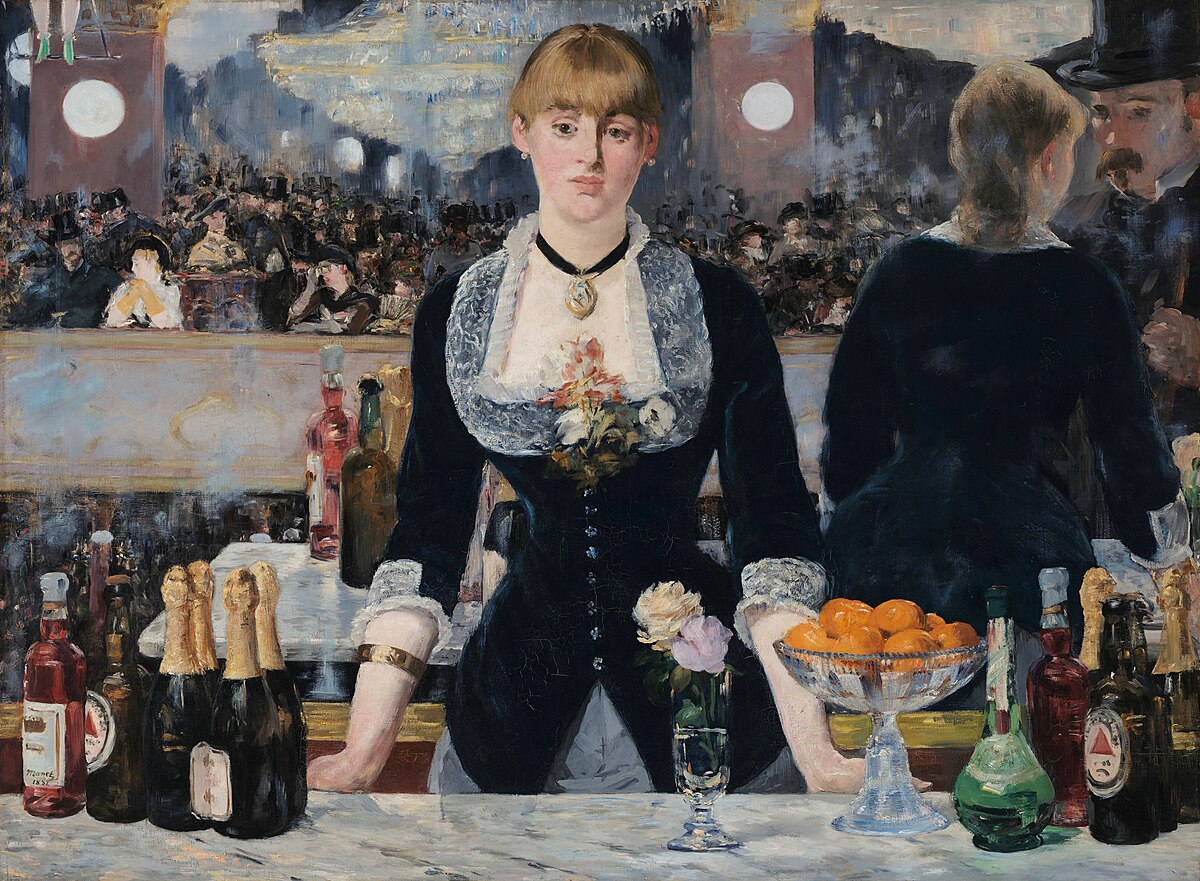Introduction
Édouard Manet’s “A Bar at the Folies-Bergère,” completed in 1882, is often hailed as one of the masterpieces of late 19th-century French painting. This work, rich in detail and complexity, captures the essence of Parisian nightlife while posing intriguing questions about perception and reality. In this article, we will explore the intricate layers of Manet’s final major work, delving into its spatial dynamics and the subtle interplay between the barmaid and her surroundings.
The painting is celebrated not only for its technical brilliance but also for its profound exploration of modern life’s complexities. Through a nuanced analysis, we aim to unpack the visual conundrum Manet presents, examining how “A Bar at the Folies-Bergère” blurs the lines between reflection and reality.
Historical Context
The late 19th century in Paris was a period of rapid societal change and artistic innovation. The city, undergoing a phase of modernization, was bustling with the energy of urban life. In this context, the Folies-Bergère, a popular nightclub, became a symbol of Parisian social life, a place where the bourgeoisie and the working class mingled.
Manet, a pivotal figure in the transition from Realism to Impressionism, was deeply interested in capturing the spirit of his times. “A Bar at the Folies-Bergère” is a testament to this interest, reflecting the vibrant yet often alienating atmosphere of modern urban life. The painting, rich in detail and layered with meaning, offers a window into the Parisian social milieu of the era.
Description of the Painting
In “A Bar at the Folies-Bergère,” Manet depicts a barmaid standing before a large mirror, which reflects the bustling nightlife of the bar. The composition is complex, with the mirror playing a crucial role in shaping the viewer’s perception. The barmaid, central to the scene, appears detached and introspective, contrasting with the lively atmosphere suggested in the mirror’s reflection.
The spatial arrangement in the painting is one of its most intriguing aspects. The reflection in the mirror seems to contradict the physical space of the bar, creating a sense of disorientation. This deliberate spatial ambiguity is a key element of Manet’s visual conundrum, challenging the viewer to discern the boundaries between reality and reflection.
Artistic Techniques and Innovations
Manet’s technique in “A Bar at the Folies-Bergère” demonstrates his mastery of color, light, and composition. His brushwork, while loose, captures intricate details that bring the scene to life. The use of reflection and perspective is particularly innovative, as Manet plays with visual perception in a way that was groundbreaking for his time.
The painting also marks a departure from traditional portraiture and genre scenes. Manet’s focus on the barmaid, a figure from everyday life, and his portrayal of her in a contemporary setting, reflect the changing focus of art towards modernity and realism. This approach was indicative of a broader shift in the art world, moving away from idealized subjects to a more authentic representation of contemporary life.
Deeper Analysis of Spatial Dynamics
The spatial dynamics in “A Bar at the Folies-Bergère” are central to its intrigue. The mirror’s reflection raises questions about the nature of reality and perception. The reflection suggests a bustling bar scene, yet the barmaid’s expression and the foreground’s stillness create a contrasting sense of isolation. This juxtaposition highlights the alienation often felt in urban environments, despite being surrounded by people.
Moreover, the way Manet manipulates space challenges traditional perspectives. The viewer’s position seems to be that of a customer at the bar, yet the reflection doesn’t correspond to this viewpoint. This dissonance invites the audience to question their role as an observer and the reliability of their perception, themes that resonate with the modernist exploration of subjective experience.
Symbolism and Social Commentary
Beyond its technical prowess, “A Bar at the Folies-Bergère” is rich in symbolism and social commentary. The barmaid, portrayed as both present and distant, symbolizes the dual role of women in modern society – visible yet often overlooked. Her expression, reflective and somber, suggests an inner world at odds with her public facade.
The painting also comments on the nature of leisure and entertainment in modern urban life. The Folies-Bergère was a place of spectacle and diversion, yet Manet’s portrayal hints at a more complex, perhaps even somber, undercurrent. This dual perspective offers a critique of Parisian society, reflecting the nuances and contradictions of the modern condition.
Influence and Legacy
Manet’s “A Bar at the Folies-Bergère” had a profound impact on the course of modern art. Its innovative approach to spatial construction and perspective influenced a generation of artists, including the Impressionists and later, the Cubists. The painting’s exploration of modern life and its complexities contributed to the evolving narrative of art, moving away from idealization to a more critical and realistic depiction of society.
The legacy of “A Bar at the Folies-Bergère” extends beyond its artistic innovations. It represents a pivotal moment in the portrayal of modern life, capturing the essence of an era marked by rapid change and complexity. Today, the painting stands as a key work in understanding the transition from traditional to modernist art, a testament to Manet’s enduring influence on the art world.
Conclusion
Édouard Manet’s “A Bar at the Folies-Bergère” is a masterpiece that encapsulates the complexities of modern urban life and the challenges of artistic representation. Through its innovative use of space, reflection, and perspective, the painting invites viewers to explore the depths of reality and perception. It stands as a landmark work in Manet’s career and a critical piece in the narrative of modern art, offering insights into the societal and cultural shifts of late 19th-century Paris. As such, “A Bar at the Folies-Bergère” remains a vital work for understanding the evolution of art and the enduring questions it raises about our perception of the world around us.
